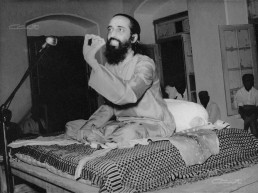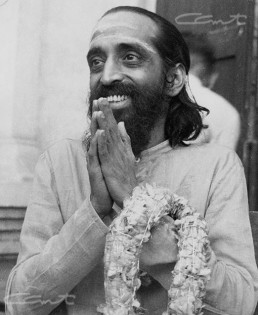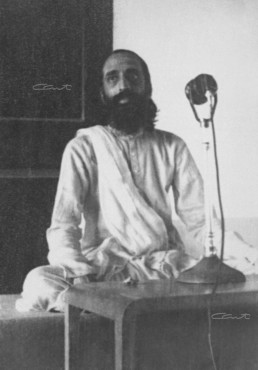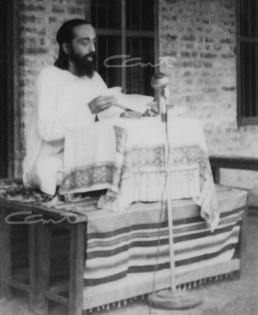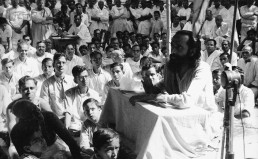
Jnana Yajna 2

Year & Dates:
April 25, 1953 to June 05, 1953

Yajna Topics:
Mundaka Upanishad

Place:
Arni Palace, Egmore, Chennai, India
What started with the blessings of Lord Ganesha and mesmerized the crowds in Pune was gathering momentum. The daring sage from the Himalayas could sense that the revival of Hinduism was afoot. But the path ahead was still full of challenges as Pujya Gurudev Swami Chinmayananda arrived in the rituals-focused southern city of Madras (now Chennai) to launch his second Jnana Yajna. A discouraged organizing committee, a prejudiced and unwilling public, and a lack of even a proper venue for the talks – nothing dampened the enthusiasm of the selfless Swami. The purity of His purpose prompted a most unlikely patron – a Muslim offered his place for the universal essence of Hinduism to ring out loud.
The Mission is Born!
On the evening of April 25, 1953, the first few listeners who sat in the spacious courtyard before Arni Palace in Egmore, inside the pandal (tent) with its flickering petromax lanterns, were entranced by the stately Swami Chinmayananda. They recall being overcome “by an awe-inspiring Presence of the Supreme.” By the end of that 41-day yajna, the pandal couldn’t contain the increasing crowds that stood captivated by Pujya Gurudev’s matchless discourses on Mundakopanishad.
The skeptical listeners in Chennai who were transformed into spirited seekers appealed to Swami Chinmayananda that summer of 1953. They wanted to form “Chinmaya Mission” as an organization to enable them to reflect and absorb the teachings after every Jnana Yajna. At first, Pujya Gurudev refused to be institutionalized. However when the group of devotees in Madras(Chennai) insisted that the word ‘Chinmaya’ referred to the Supreme, Pure Knowledge that they aspired to gain, He agreed to the name “Chinmaya Mission.” Thus, on August 8, 1953, was born Chinmaya Mission whose branches would soon encircle the world.
In Admiration
“Offering of all our negativities and animalism into the fire of Knowledge is what I meant by Jnana Yajna,” is how Pujya Gurudev Swami Chinmayananda described as he emphasized on deep Hindu ideas such as self-restraint and self-training through relentless sadhana during his 2nd Jnana Yajna. Shri R Gopalakrishnan, a devotee who attended his early Yajnas in Chennai recounts, “Sitting on His mattress of easy camaraderie, Swami Chinmayananda used to dissect our day-to-day life and religion with his double-edged sword of Reason and Logic. The “Lion of Vedanta” expounded the esoteric science of Advaitic Philosophy in a language at once mellifluous, sonorous and roaring. The highlight of his lectures is undoubtedly the telling effect of his homely smiles deftly employed to exhibit the same thought from several points of view. The congregational meditation at the conclusion of the daily lectures has captivated many!”
Photo Gallery

“Think,” says Pujya Gurudev!
The Upanishad-Seers, by a process of complete elimination of their ego, achieved through the divine method of sublimation, when they reached the Palace of Truth, they entered therein to rediscover themselves to be the owners of it. That Realm of Perfection is indeed the world which having reached no one returneth. However, there are some among them, rare birds, who had flown back, in their divinely selfless game of service, to lead, guide and encourage other manifestations of themselves, unto the same Truth. They try to express the topography of the Realms-Beyond and the main paths by which one may reach it.
At such moments of Godly inspiration and intoxicating bliss the Rishis forgot to subscribe their names to their own masterpieces, the Upanishads! Thus, we have an incomparable literature on philosophy in the volumes of the Upanishads, the authors of which are unknown to us. We only know that there was behind these sparkling words of wisdom a personality who reveled in the subjective experience of the very theme which they describe in such a wealth of details.
From Mundakopanishad, first edition June 1953 page 4-5
Insights from Mundakopanishad Talks in Pittsburgh (1984)
Discover the Upanishadic metaphor of the bow and arrow, where the Upanishad serves as the bow and the mind as the arrow. Learn the art of sharpening the mind through worship, prayer, and various yogas. Dive into the discourse on Ayamya Yoga, understanding the importance of turning the mind towards the divine reality. Explore the powerful analogy of the arrow hitting its target, symbolizing the dissolution of the self into the state of consciousness. Join Pujya Gurudev in unraveling the transformative wisdom of the Upanishadic teachings.
